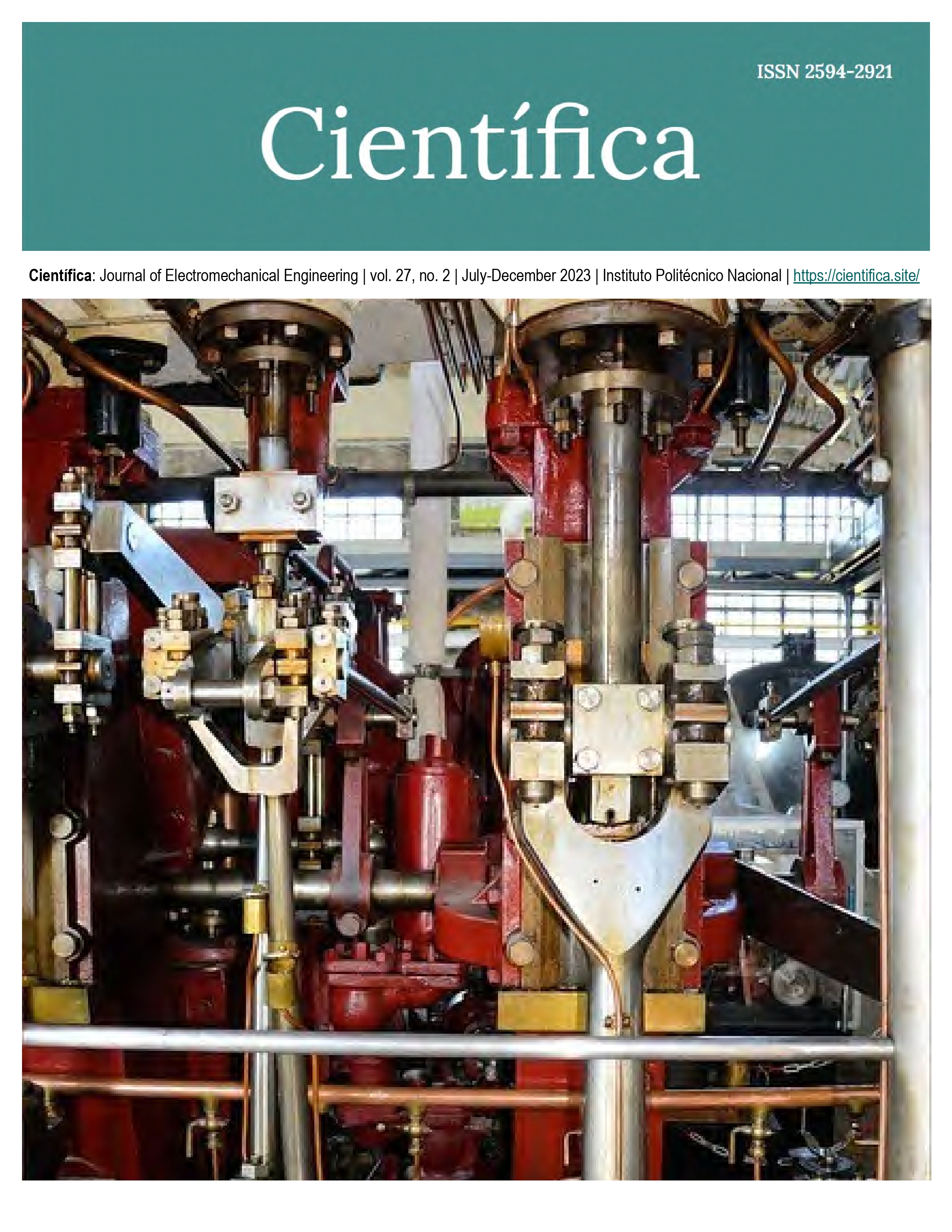Implementation of a haptic interface in Unreal Engine and the estimation of speeds to reduce vibrations
DOI:
https://doi.org/10.46842/10.46842/ipn.cien.v27n2a08Keywords:
haptic interface, derivators, sampling times, Unreal Engine, experimental platformAbstract
This work addresses the implementation of a haptic interface in Unreal Engine in conjunction with a one-degree-of-freedom robot. Unreal Engine is a powerful free rendering and simulation engine in which a digital twin was developed capable of interacting with a physical platform through bidirectional communication of position and torque for trajectory tracking and force reflection. Different experiments were conducted to validate the technological integration under different operating conditions. The result was a low-cost platform with an acceptable haptic feel and a digital environment to visualize, analyze, and understand digital twin technology and the challenges faced. Several different methods were also tested to figure out how fast and significantly to lower the system's vibrations caused by communication delays, which are bad for the accuracy and quality of the robotic interaction.
References
C. Semararo, M. Lezoche, P. Hervé, M. Dassisti, “Digital twin paradigm: A systematic literature review”, Computers in Industry, vol. 130, p. 103-469, 2021.
Z. Wang, X. Liao, X. Zhao, K. Han, P. Tiwari, M. J. Barth, G. Wu, “A digital twin paradigm: Vehicle-to'cloud based advanced driver assistance systems”, en 2020 IEEE 91st Vehicular Technology Conference (VTC2020-Spring), 2020.
E. Glaessgen, D. Stargel, “The digital twin paradigm for future NASA and US Air Force vehicles”, en 53rd AIAA/ASME/ASCE/AHS/ASC Structures, Structural Dynamics and Materials Conference 20th AIAA/ASME/AHS adaptive structures conference 14th AIAA, 2012.
W. Yu, P. Panos, B. Young, E. Klinac, T. G. Walmsley, “Energy digital twin technology for industrial energy management: Classification, challenges and future”, Renewable and Sustainable Energy Reviews, vol. 161, pp. 112-407, 2022.
W. Kritzinger, M. Karner, G. Traar, J. Henjes, W. Sihn, “Digital Twin in manufacturing: A categorical literature review and classification”, Ifac-PapersOnline, vol. 51, pp. 1016-1022, 2018.
M. Faisal, F. Laamarti, A. El Saddik, “Digital Twin Haptic Robotic Arms: Towards Handshakes in the Metaverse”, Electronics, vol. 12, 2023.
A. Fuller, Z. Fan, C. Day, C. Barlow, “Digital twin: Enabling technologies, challenges and open research”, IEEE access, vol. 8, pp. 108952-108971, 2020.
C. K. Liu, D. Negrut, “The role of physics-based simulators in robotics”, Annual Review of Control, Robotics, and Autonomous Systems, vol. 4, pp. 35-58, 2021.
J. Resch, J. Ehrentraut, M. Barnett-Cowan, et al., “Gamified automation in immersive media for education and research”,» arXiv preprint:1901.00729, 2018.
F. Jiang, Q. Hao, “Pavilion: Bridging Photo-Realism and Robotics”, en 2019 International Conference on Robotics and Automation (ICRA), 2019.
Y. Zheng, S. Yang, H. Cheng, “An application framework of digital twin and its case study”, Journal of Ambient Intelligence and Humanized Computing, vol. 10, pp. 1141-1153, 2019.
G. Steindl, M. Stagl, L. Kasper, W. Kastner, R. Hofmann, “Generic digital twin architecture for industrial energy systems”, Applied Sciences, vol. 24, p. 8903, 2020.
Y. Lu, C. Liu, I. Kevin, K. Wang, H. Huang, X. Xu, “Digital Twin-driven smart manufacturing: Connotation, reference model, applications and research issues”, Robotics and computer-integrated manufacturing, vol. 61, p. 101837, 2020.
C. Boje, A. Guerriero, S. Kubicki, Y. Rezgui, “Towards a semantic Construction Digital Twin: Directions for future research”, Automation in construction, vol. 114, p. 103179, 2020.
J. Leudet, F. Christophe, T. Mikkonen, T. Mannisto, “Ailivesim: An extensible virtual environment for training autonomous vehicles”, en 2019 IEEE 43rd annual computer software and applications conference (COMPSAC), 2019.
S. Jeršov, “Development of Digital Twin in extended Reality with Unreal Engine”, Tesis, Tal Tech- School of Information Technologies, Estonia, 2020.
Y. A. El-Wajeh, P. V. Hatton, N. J. Lee, “Unreal Engine 5 and immersive surgical training: translating advances in gaming technology into extended-reality surgical simulation training programmes”, British Journal of Surgery, vol. 109, pp. 470-471, 2022.
Y. Wang, G. Zheng, D. Efimovk, W. Perruquetti, “Differentiator application in altitude control for an indoor blimp robot”, International Journal of Control, vol. 91, pp. 2121-2130, 2018.
Y. Matsumoto, S. Katsura, K. Ohnishi, “An analysis and design of bilateral control based on disturbance observer”, en IEEE International Conference on Industrial Technology 2003, vol. 2, pp. 802-807, 2003.
D. Yashiro, K. Ohnishi, “Performance Analysis of Bilateral Control System With Communication Bandwidth Constraint”, IEEE Transactions on Industrial Electronics, vol. 58, pp. 436-443, 2011.
H. Z. Tan, M. A. Srinivasan, B. Eberman, B. Cheng, “Human factors for the design of force-reflecting haptic interfaces”, Dynamic Systems and Control, vol. 55, pp. 353-359, 1994.
H. Li, L. Zhang, K. Kawashima, “Operator dynamics for stability condition in haptic and teleoperation system: A survey”, The International Journal of Medical Robotics and Computer Assisted Surgery, vol. 14, p. e1881, 2018.
A. Colomé, D. Pardo, G. Alenya, C. Torras, “External force estimation during compliant robot manipulation”, en 2013 IEEE International Conference on Robotics and Automation, 2013.
Repositorio de GITHUB: https://github.com/erick-man11/InterfazHaptica_UE5, 2019.
Downloads
Published
Issue
Section
License
Copyright (c) 2023 Instituto Politecnico Nacional

This work is licensed under a Creative Commons Attribution-NonCommercial-ShareAlike 4.0 International License.

